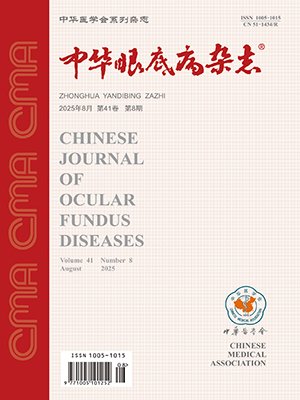| 1. |
Fu HZ, Cheng J, Xu YW, et al. Joint optic disc and cup segmentation based on multi-label deep network and polar transformation[J]. IEEE Trans Med Imag, 2018, 37(7): 1597-1605. DOI: 10.1109/TMI.2018.2791488.
|
| 2. |
Lu SJ, Lim JH. Automatic optic disc detection from retinal images by a line operator[J]. IEEE Trans Biomed Eng, 2011, 58(1): 88-94. DOI: 10.1109/TBME.2010.2086455.
|
| 3. |
Zhang DB, Zhao YY. Novel accurate and fast optic disc detection in retinal images with vessel distribution and directional characteristics[J]. IEEE J Biomed Health Inform, 2015, 20(1): 333-342. DOI: 10.1109/JBHI.2014.2365514.
|
| 4. |
Cheng J, Liu J, Wong DW, et al. Automatic optic disc segmentation with peripapillary atrophy elimination[C]. International Conference Proceedings of IEEE Engineering in Medicine and Biology Society, 2011: 6224-6227. DOI: 10.1109/IEMBS.2011.6091537.
|
| 5. |
Joshi GD, Sivaswamy J, Krishnadas SR. Optic disk and cup segmentation from monocular color retinal images for glaucoma assessment[J]. IEEE Trans Med Imag, 2011, 30(6): 1192-1205. DOI: 10.1109/TMI.2011.2106509.
|
| 6. |
Yin F, Liu J, Ong S H, et al. Model-based optic nerve head segmentation on retinal fundus images[C]. Engineering in Medicine and Biology Society, 2011: 2626-2629. DOI: 10.1109/IEMBS.2011.6090724.
|
| 7. |
Tang L, Garvin MK, Kwon YH, et al. Segmentation of optic nerve head rim in color fundus photographs by probability based active shape model[J]. Invest Ophthalmol Vis Sci, 2012, 53(14): 2144.
|
| 8. |
Cheng J, Liu J, Xu YW, et al. Superpixel classification based optic disc and optic cup segmentation for glaucoma screening[J]. IEEE Trans Med Imag, 2013, 32(6): 1019-1032. DOI: 10.1109/TMI.2013.2247770.
|
| 9. |
Lu HT, Zhang QC. Applications of deep convolutional neural network in computer vision[J]. J Data Acquisition Process, 2016, 31(1): 1-17. DOI: 10.16337/j.1004-9037.2016.01.001.
|
| 10. |
童妍, 卢苇, 邢怡桥, 等. 人工智能在眼科诊断中的应用研究现状[J]. 中华眼底病杂志, 2019, 35(5): 506-509. DOI: 10.3760/cma.j.issn.1005-1015.2019.05.019.Tong Y, Lu W, Xing YQ, et al. Applications of artificial intelligence in the diagnosis of eye diseases[J]. Chin J Ocul Fundus Dis, 2019, 35(5): 506-509. DOI: 10.3760/cma.j.issn.1005-1015.2019.05.019.
|
| 11. |
陈有信, 张碧磊, 张弘哲, 等. 眼科人工智能技术的现状与问题[J]. 中华眼底病杂志, 2019, 35(2): 119-123. DOI: 10.3760/cma.j.issn.1005-1015.2019.02.003.Chen YX, Zhang BL, Zhang HZ, et al. Insights and prospectives of ophthalmologic artificial intelligence technology[J]. Chin J Ocul Fundus Dis, 2019, 35(2): 119-123. DOI: 10.3760/cma.j.issn.1005-1015.2019.02.003.
|
| 12. |
Esedoglu S, Shen J. Digital in painting based on the Mumford-Shah-Euler image model[J]. Eur J Appl Math, 2002, 13(4): 353-370. DOI: 10.1017/S0956792502004904.
|
| 13. |
Liang JL, Zhang MH, Liu D, et al. Robust ellipse fitting based on sparse combination of data points[J]. IEEE Trans Image Process, 2013, 22(6): 2207-2218. DOI: 10.1109/TIP.2013.2246518.
|
| 14. |
Zhang Z, Yin FS, Liu J, et al. ORIGA-light: an online retinal fundus image database for glaucoma analysis and research[C]. International Conference of IEEE Engineering in Medicine & Biology Society, 2010: 3065-3068. DOI: 10.1109/IEMBS.2010.5626137.
|
| 15. |
Xu J, Chutatape O, Sung E, et al. Optic disk feature extraction via modified deformable model technique for glaucoma analysis[J]. Pattern Recognition, 2007, 40(7): 2063-2076. DOI: 10.1016/j.patcog.2006.10.015.
|
| 16. |
Cheng J, Liu J, Xu Y, et al. Superpixel classification based optic disc and optic cup segmentation for glaucoma screening[J]. IEEE Transactions on Medical Imaging, 2013, 32(6): 1019-1032. DOI: 10.1109/TMI.2013.2247770.
|
| 17. |
Xu Y, Xu D, Lin S, et al. Sliding window and regression based cup detection in digital fundus images for glaucoma diagnosis[C]. International Conference on Medical Image Computing and Computer-Assisted Intervention, 2011, 14: 1-8. DOI: 10.1007/978-3-642-23626-6_1.
|




